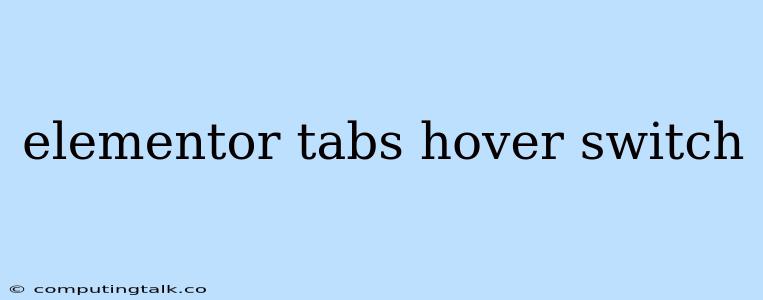Elementor is a popular WordPress website builder that offers a variety of tools to create stunning and functional websites. One of the features that Elementor provides is the ability to create custom tabs. Tabs are a great way to organize content and make it easy for visitors to navigate. This article will explore how to create Elementor tabs with a hover effect, as well as how to incorporate a switch to toggle between tabs.
Understanding Elementor Tabs
Elementor tabs are essentially containers that hold different pieces of content. Each tab has a title or label that users can click on to view the associated content. When a tab is clicked, the corresponding content panel is displayed while other content panels are hidden. This allows you to present information in a compact and organized manner, making it easy for users to find what they are looking for.
Creating Basic Elementor Tabs
To create Elementor tabs in your WordPress site, follow these steps:
- Open the Elementor editor: Navigate to the page or post where you want to add the tabs. Click on the "Edit with Elementor" button.
- Add the Tabs widget: In the Elementor editor, search for "Tabs" in the widget library and drag and drop it onto the desired section.
- Configure the tabs:
- Tab Title: Give each tab a descriptive title that accurately reflects the content it will display.
- Tab Content: Add your content to each tab. You can use any Elementor widget or element within the tab content area.
- Customize appearance: Use the Elementor style options to customize the look and feel of your tabs, including colors, fonts, and spacing.
Adding Hover Effects to Elementor Tabs
To enhance the user experience, you can add a hover effect to your Elementor tabs. This will visually highlight the selected tab, making it more noticeable and interactive.
- Choose the hover effect: There are several ways to achieve a hover effect:
- Background color change: Set a different background color for the tab when hovered.
- Text color change: Change the text color of the tab title on hover.
- Border highlight: Add a border around the tab that changes color or thickness on hover.
- Apply the effect: Use Elementor's "State" options within the style settings for your tabs. Select "Hover" and then apply your desired style changes.
Implementing a Tab Switch
A tab switch allows users to toggle between tabs using a button or other interactive element. This can be particularly useful if you want to provide alternative views of the same content.
- Add a switch element: Select a suitable Elementor widget to act as your tab switch. This could be a button, toggle, or another element.
- Link the switch to tabs: Use Elementor's "Conditional Logic" feature to associate your switch with specific tabs. This will control which tab is visible based on the state of the switch. For example, you could have a "View Desktop" and "View Mobile" switch that toggles between two tabs showing different versions of content.
Tips for Creating Effective Elementor Tabs
- Keep tabs concise: Use short, descriptive titles that clearly indicate the content within each tab.
- Maintain consistency: Use consistent styling for your tabs throughout your website to ensure a cohesive design.
- Prioritize content: Place the most important content in the first tab or make it the default tab.
- Use a clear call to action: Include a clear call to action within each tab to guide visitors to the next step.
Conclusion
Elementor tabs offer a versatile way to organize content and create a user-friendly website experience. By adding hover effects and a tab switch, you can further enhance the interactivity and visual appeal of your tabs. Experiment with different styles and features to find the combination that best suits your website's needs.
